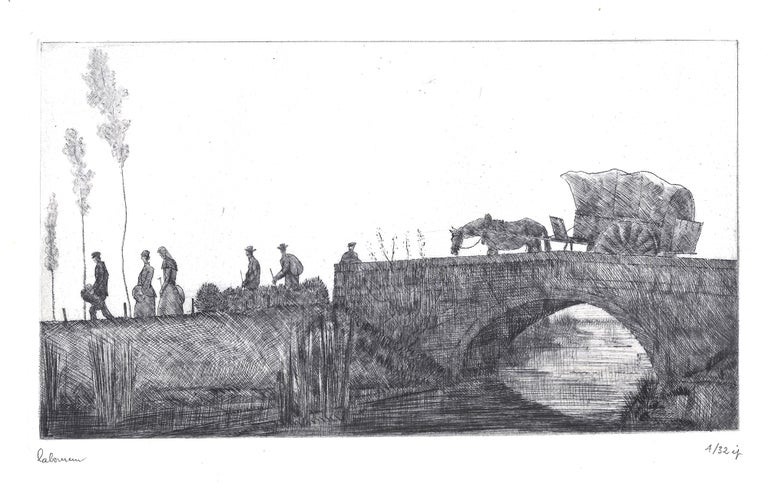
Le Pont
1932. Etching, engraving, roulette and drypoint on watermarked BFK Rives wove paper, 5 x 8 3/4 inches (126 x 222 mm), full margins. Signed and numbered 4/32 in pencil, lower margin. Minor handling creases at the lower extreme corner, and archival paper tape remnants at the top sheet edge (from a former mount), otherwise in very good condition. An excellent, clean and silvery impression of this image, with all the fine lines printing clearly.
Born in 1877 into a monied, bourgeoisie family in Nantes, southwest of Paris, Laboureur spent a short time studying law at his father's behest. It was soon after his arrival in Paris in 1895 that he decided to follow his passion, and abandoned his legal studies to take up tutelage at the Académie Julian, where he was instructed in engraving by Auguste-Louis Lepère. Recognized as the leader of the creative revival of woodcut engraving in France, Lepère was a highly influential force in Laboureur's early composition, which was largely primitive in nature, not unlike the print work of Paul Gauguin. Laboureur's first showing at the Paris salon was in 1896. After his studies ended, having had the luxury to travel, Laboureur made numerous trips to North America in the early 1900s to show his work in New York and in various cities in Canada. He also traveled to show in England, Turkey and Greece. Upon his arrival back in Europe he settled in Paris, and focused almost entirely on etching. Having found himself conscripted at the outbreak of WWI, he published three series of engravings in the years that followed, all centered on the theme of war. After the war ended, and life in Paris resumed, Laboureur took on students in his busy workshop, notably including Marie Laurencin and André Dunoyer de Segonzac. Laboureur enjoyed a prosperous career illustrating books (sixty-six titles in all, including works by Marcel Proust), writing essays on engraving, and authoring books, notably Considérations sur la gravure originale (1928), published in Brussels. He purchased a house in Brittany, and spent his time taking in the landscape that was once painted by the artistic forces of his youth, once again, including Paul Gauguin. Laboureur produced many Breton landscapes during the 1930s, perhaps including this scene of one of the scores of small tributaries that feed the canals that run through the French countryside. Laboureur eventually retired to Pénestin, in Brittany, where he took ill and passed in 1943. His legacy includes a body of work that can be viewed at Musée du Louvre, the Musée d'Orsay, the Musée des Beaux-Arts de Nantes and the Musée d'Art moderne Richard Anacréon, as well as on two French national postage stamps.
Item number: 403
Price: $275.00
Share: